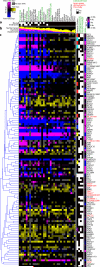Genetic conflict reflected in tissue-specific maps of genomic imprinting in human and mouse
- PMID: 25848752
- PMCID: PMC4414907
- DOI: 10.1038/ng.3274
Genetic conflict reflected in tissue-specific maps of genomic imprinting in human and mouse
Abstract
Genomic imprinting is an epigenetic process that restricts gene expression to either the maternally or paternally inherited allele. Many theories have been proposed to explain its evolutionary origin, but understanding has been limited by a paucity of data mapping the breadth and dynamics of imprinting within any organism. We generated an atlas of imprinting spanning 33 mouse and 45 human developmental stages and tissues. Nearly all imprinted genes were imprinted in early development and either retained their parent-of-origin expression in adults or lost it completely. Consistent with an evolutionary signature of parental conflict, imprinted genes were enriched for coexpressed pairs of maternally and paternally expressed genes, showed accelerated expression divergence between human and mouse, and were more highly expressed than their non-imprinted orthologs in other species. Our approach demonstrates a general framework for the discovery of imprinting in any species and sheds light on the causes and consequences of genomic imprinting in mammals.
Figures



References
-
- Barlow DP. Gametic imprinting in mammals. Science. 1995;270:1610–3. - PubMed
-
- Moore T, Haig D. Genomic imprinting in mammalian development: a parental tug-of war. Trends Genet. 1991;7:45–9. - PubMed
-
- Wilkins JF, Haig D. What good is genomic imprinting: the function of parent- specific gene expression. Nat Rev Genet. 2003;4:359–68. - PubMed
Publication types
MeSH terms
Grants and funding
- R01 GM097171/GM/NIGMS NIH HHS/United States
- U01 HG007593/HG/NHGRI NIH HHS/United States
- R01 MH090936/MH/NIMH NIH HHS/United States
- MH090948/MH/NIMH NIH HHS/United States
- MH090936/MH/NIMH NIH HHS/United States
- MH090941/MH/NIMH NIH HHS/United States
- R01 MH090951/MH/NIMH NIH HHS/United States
- 1R01GM097171-01A1/GM/NIGMS NIH HHS/United States
- MH090951/MH/NIMH NIH HHS/United States
- R01 DA006227/DA/NIDA NIH HHS/United States
- MH090937/MH/NIMH NIH HHS/United States
- R01 MH090948/MH/NIMH NIH HHS/United States
- R01 MH090941/MH/NIMH NIH HHS/United States
- HHSN261200800001C/RC/CCR NIH HHS/United States
- R01 MH090937/MH/NIMH NIH HHS/United States
- HHSN268201000029C/HL/NHLBI NIH HHS/United States
- U01HG007593/HG/NHGRI NIH HHS/United States
- HHSN261200800001E/CA/NCI NIH HHS/United States
LinkOut - more resources
Full Text Sources
Other Literature Sources
Molecular Biology Databases

